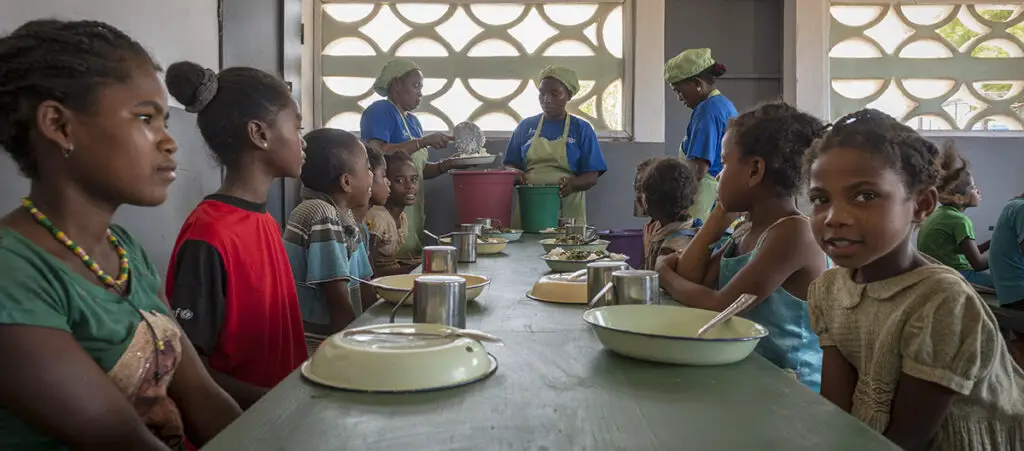- ECOWAS member states fed 22.4 million school-going children in 2022, up from 20 million learners in 2020.
- This represents 42% of the 53 million school children in Sub-Saharan Africa who were fed through school feeding programs last year.
- School feeding intervention, as it happens in Rwanda, can immensely boost agriculture, education, health and nutrition, and social protection sectors.
The past two years have seen West African countries grapple with a number of crises driven by conflict, climate shocks, and a slow recovery from COVID-19 economic fallout worsened by the ongoing Russia-Ukraine war.
The Economic Community of West African States (ECOWAS) member States are, however, defying these tough economic times, emerging as having fed the largest number of school-aged children in Africa.
According to The 2022 State of School Feeding Worldwide report, Ecowas member states fed 22.4 million school-going children in 2022. This was an increase from 20 million children fed in 2020. The number of children fed within Ecowas bloc was 42 per cent of the 53 million learners in Sub-Saharan Africa who benefited from school feeding programs last year.
ECOWAS’ school feeding gains
According to the World Bank, the single intervention of school feeding can have positive effects across at least four different sectors including agriculture, education, health and nutrition, and social protection. The report indicates that for every $1 invested in feeding school children $9 is achieved in economic returns.
Additionally, school feeding programs that procure food locally can offer additional benefits for smallholder farmers. It supports local food production and economies while promoting sustainable local markets in offering diverse, nutritious foods.
School meals also serve as an important safety net, supporting families’ efforts to counter food insecurity and enhancing supply chains.
Budgets and economic gains
In the Ecowas countries, 85 percent of school meal programs are funded by domestic budgets. Overall, these programs have created over 200,000 direct jobs in 11 Ecowas countries. Those employed are mainly women as cooks, food packers, quality control agents, processors and transporters.
“The introduction of school meals programs based on local production can, among other things reduce poverty, increase school enrolment, generate income, add value to local products, and promote community cohesion, stability and productivity,” Ecowas Commissioner Professor Fatou Sow-Sarr said.
This indicates that when school meals are locally procured, the feeding program strengthens local food systems. It equally builds stable markets, and helps grow local agriculture and supply chain systems.
“Homegrown school meals are more than a meal. They are a gateway to a better, healthier, and more prosperous future, and a platform that nourishes the next generation, creating jobs, economic growth, and longer-term development for entire countries,” the World Food Programme’s Regional Director for Western Africa Margot van der Velden notes.
“At WFP, we are humbled by the progress made by national governments and remain committed to working with all partners to ensure children have access to education and the nutritious food they need to thrive and grow into productive adults tomorrow,” she added.
Van der Velden spoke during a two-day conference entitled; “Investing in homegrown school meals to strengthen human capital, women’s economic empowerment and contribute to economic development”.
Over 100 technical experts, including government officials, policymakers, donor representatives, and researchers from the education, agriculture, gender, and social protection sectors drawn from West Africa met in Dakar, Senegal, to share knowledge and best practices on rolling out school meals programs using locally-sourced food.
Financing woes facing school meals plan
According to the World Bank, domestic financing is the main source of funding in all countries. In low-income countries however international donors remain the primary source of funds in school feeding programs. Despite this external support, funding in low-income countries remains low.
The report indicates that aid donors and multilateral development banks have also underinvested as overall aid to school meals in 2022 was $214 million, a drop from $267 million in 2020. This is because fiscal space has been shrinking due to slower growth, reduced revenues and piling external debt pressures.
However, low-income countries still managed to increase their investments from 30 per cent in 2020 to 45 per cent in 2022.
A 2022 UNESCO report found that though school feeding programs are driving higher enrolment, they’re limited as they rely heavily on external funding.
Governments in low-income countries currently only cover 38 per cent of the total cost of these programs. This percentage falls to 33 per cent in Eastern and Western Africa and only three percent in Central Africa.
Rwanda, success story in school meals programs
The Government of Rwanda has shown impressive leadership in expanding its school feeding program and is working towards strengthening its quality. Launched in October 2021, the Rwanda National School Feeding Programme provides meals to school-going children up to secondary school level.
Rwanda government covers 89 per cent of the cost with the remaining 11 per cent being out of pocket spending by families. The families opt for either cash or in-kind contributions, such as food items, labor, and firewood.
Rwanda’s Minister of Education maintains that the government will achieve universal coverage of school feeding for basic education. Data shows Kigali increased its school feeding program budget to $33 million in 2021 from $8 million in 2020.
The increasing budget is showing positive results. In 2022, Rwanda has announced increasing national school feeding coverage from 660,000 to 3.8 million students, alongside another budget increase, from $33 million to $74 million.
Rwanda is also working to strengthen program links to local markets. This is through the development of local supply chains in close collaboration with stakeholders in the agriculture sector.
“The aim is to maximize the benefits of the program and expand them to benefit the whole community. Currently, the government is working closely with the Sustainable Financing Initiative and the Research Consortium to document its impressive achievements and to learn from other governments how to sustain and keep growing its success,” the World Bank said in a report.
Kenya’s school feeding program
Similarly, Nairobi City County, covering Kenya’s capital, recently launched “the largest school meals program in Africa” aimed at eliminating the “shame of hunger” and providing daily lunches for primary school children.
According to the office of the Governor, the school feeding program has established ten new kitchens providing 400,000 daily lunches for children in 225 primary schools and Early Childhood Development centers in Nairobi.
In addition to feeding the children, the initiative is creating employment opportunities for 3,500 people and a market for dozens of farmers. Kenya’s program is a collaboration between Nairobi County and Food4educatuin, which already supplies meals to 150,000 primary schoolchildren in the city.
The government has allocated $36 million to increase the reach of the current national feeding program to 4 million children from 1.6 million.
Read Also: Pain for Kenyan parents as school fees goes up ten-fold




